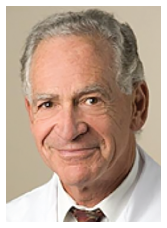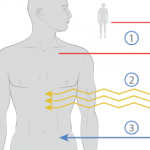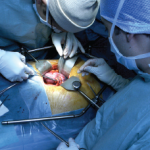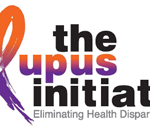
Samuel Strober, MD: 1940–2022
Samuel Strober was born on May 8, 1940, in Brooklyn, N.Y., the oldest son of Lee and Julius Strober. Sam attended Public School 92 in Brooklyn and Stuyvesant High School in Manhattan, and graduated from Columbia College, New York, in 1961, and Harvard Medical School, Boston, in 1966.
While in high school, Sam won a prize at the National Science Fair in Los Angeles for building an electrophoresis device that detected an abnormal immunoglobulin spike in a patient with multiple myeloma, ironically the disease that ultimately took his life.
He entered Columbia College as a physics major, but his interest turned to premedical studies, impacted in part by three roommates in the Tau Epsilon Phi (ΤΕΦ) fraternity house, Max Cohen, Steve Shappell and Ted Pincus, as well as Jay Jackman and Stephen Wang, with whom he maintained lifetime friendships, as well as with other brothers, Ira Novak, Michael Schachter, Joel Blumen, Joel Merker and Hillel Hoffman. Sam was president of the fraternity in 1960–61, a sign of his many future leadership capacities. This group kept in touch over the years and enjoyed being together for a 50th anniversary reunion in 2011 and a Zoom 60th reunion in 2021.
At Harvard Medical School, Sam had a part-time student position in the laboratory of Joseph E. Murray, MD, FACS, which kindled a scientific passion concerning organ transplantation that endured over the next 60 years. Dr. Murray pioneered kidney transplantation and shared the 1990 Nobel Prize for Medicine with E. Donnall Thomas, MD, who pioneered bone marrow transplantation, a procedure Sam ultimately underwent to gain 20 months of life.
Sam pursued transplantation research in the laboratory of James Gowans, MB, DPhil, FRCP, FRS, at Oxford University, U.K., between his third and fourth years of medical school. His research recognized that transplant rejection occurred by peripheral sensitization of immune cells circulating through transplanted organs rather than transport of the organ antigens to host lymphatics.
After completing an internship at Massachusetts General Hospital, Boston, he continued immunology research in the laboratory of Lloyd W. Law, PhD, for three years (1967–70).
Sam was recruited to Stanford University in 1970 by Halsted Holman, MD, chair of medicine and one of the discoverers of antibodies to DNA in lupus, Hugh McDevitt, MD, the rheumatology chair and one of the founders of immunogenetics, Irv Weissman, MD, a pioneer in stem cell biology and regenerative medicine with whom he had worked in Dr. Gowans’ lab, and Len Herzenberg, PhD, and Lee Herzenberg, DSc, who developed fluorescence-activated cell sorting, a powerful research and clinical tool.
Over the next 51 years, Sam enjoyed a rich family life and many enduring friendships at Stanford and around the world, while contributing extensive accomplishments in pursuit of what he termed the holy grail: organ transplantation without a need for immunosuppressive medications. Sam worked with dozens of scientific collaborators, most prominently Edgar Engleman, MD, and Robert Lowsky, MD, dear friends, collaborators, and business partners over decades.
Sam was promoted to professor of medicine in 1982 and served as the chief of the Division of Immunology and Rheumatology from 1978 to 1997, where he actively trained many fellows. He also mentored dozens of transplantation biologists in a laboratory that was a melting pot of many cultures and site of potluck dinners representing many cuisines.
Sam embodied both the vision to see the big picture and the intelligence and determination to implement practical, clinically effective results. His many accomplishments in rheumatology, immunology and transplantation were supported by more than $80 million in NIH grants over the years. These include:
1) The discovery that T cell numbers were dramatically reduced in patients who had total lymphoid irradiation (TLI). His collaboraters were Arthur Bobrove, MD, his first rheumatology fellow, and Henry S. Kaplan, MD, the radiotherapist who developed curative radiotherapy for Hodgkin’s lymphoma, introducing a paradigm shift to recognize that neoplastic disease could be curable.1 While immune impairment was seen in untreated Hodgkin’s patients, more profound impairment was seen within the first year after TLI with reduction of T cells, establishing a basis for designing immunosuppression for organ transplantation.
2) Demonstration that long-term survival of skin allografts in mice treated with TLI in small doses, while shielding lungs, brain and bone marrow, could overcome the problem of progressive graft-vs.-host disease, seen when only total body irradiation had been used for immunosuppression.2
3) Treatment of rheumatoid arthritis with TLI, in collaboration with Dr. Kaplan, Dr. Engleman, and Brian Kotzen, MD.3 This approach did not enter mainstream rheumatology, but was effective and recognized that many patients with RA experienced severe disease, with consequences of pain, loss of function, work disability and premature mortality that often were more severe than in Hodgkin’s disease.
4) A program for patients with heart transplants who had recurrent recalcitrant acute rejection, which allowed the majority to return to maintenance immunosuppressive therapy with resolution of ongoing tissue injury.4
5) Introduction of anti-thymocyte globulin (ATG) injections during the first few days of TLI to protect from acute graft-vs.-host disease and induce true mixed chimerism.5
6) Recognition that T cell subsets in the spleen and lymphoid tissues were skewed to favor invariant natural killer (iNK) T cells, T regulatory cells (T regs) and suppressive myeloid cells after TLI/ATS, to facilitate induction of tolerance and protection against graft-vs.-host disease.6,7
7) Sam and co-investigators translated his preclinical models of organ transplantation tolerance to human trials. They reported that 80% of recipients of an HLA-matched kidney, combined with same-donor blood stem and immune cell transplants, could discontinue all immune suppression medication, maintaining normal function without rejection episodes over years.8
Sam and his colleagues then widened their research to the much larger pool of kidney transplant recipients who receive a kidney from an HLA-mismatched related and unrelated donor. Although Sam did not see the completion of this goal, his Stanford team is dedicated to continuing the research, in part as an homage to Sam.9-11
8) Sam, Dr. Lowsky, and colleagues pursued allogeneic bone marrow transplantation using reduced-intensity conditioning (RIC), TLI + ATG, followed by infusion of granulocyte colony-stimulating factor-mobilized grafts, to treat patients with advanced leukemia and lymphoma. The Stanford Transplant Regimen is well tolerated even in older (>70 years) patients and those with significant medical comorbidities, and allowed transplantation in more than 650 patients who would otherwise have been excluded from a conventional transplant.
Hundreds of patients have been cured of advanced malignancies as a direct benefit of work by Sam and collaborators.11-13
Sam was a renaissance man, with extensive interests in history, Greek philosophy and tragedy, politics, astronomy, music and art. He established a program of humanities lectures from the general university for the medical school faculty at Stanford over 15 years ago with Peter Greenberg, MD. He established successful companies with Drs. Engleman and Lowsky. He was an accomplished handball player, an active skier, hiker and tennis player, even after his diagnosis of multiple myeloma. He also established a fund to support disadvantaged students in the Palo Alto area.
Sam was married to Myra (nee Hoffenberg) Strober, and they had two children, Jason Strober and Elizabeth (Liz) Strober-Cohen. He and Myra were divorced, and he later married Linda (nee Higgins) Strober, with whom he had two children, William (Will) Strober, and Jesse Strober. Sam and Linda also were divorced. Sam is survived by his four children, younger brother, Ross, and his two ex-wives.
Sam was a loyal friend to dozens of people, whose mourning has been outpouring in the weeks since his death. The Stanford protocol for transplantation with minimal or no immunosuppressive medications is a recognized tribute to his extensive discoveries over the years. He was an active contributor to the medical literature in 2022,11 completing a large grant renewal three weeks prior to his death, and was planning a Valentine’s Day dinner, which—alas—never took place because he passed away from multiple myeloma on Feb. 11, 2022.
Sam will be missed and mourned by hundreds of friends around the world.
About the Authors
Halsted R. Holman, MD, chaired the Department of Medicine at Stanford University from 1960, shortly after the medical school moved from San Francisco to Palo Alto, until 1971. He was responsible for the development of a new faculty of young physician/investigators, and together with Hugh McDevitt, MD, chair of the Division of Rheumatology and Immunology, recruited to Stanford James F. Fries, MD, in 1969, Samuel Strober, MD, in 1970 and Theodore Pincus, MD, in 1971. They were the initial five faculty members of the division at Stanford in the 1970s, a group in which each was characterized in some way as the “smartest guy in the room”—Dr. Holman for his incredible organizational and people skills; Dr. McDevitt as one of the founders of immunogenetics; Dr. Fries, a pioneer in outcomes research; Dr. Strober a pioneer in drug-free organ transplantation; and Dr. Pincus for ongoing advances in laboratory and clinical measurement of patients with rheumatic diseases. These obituaries are a tribute to the memory of the camaraderie and intellectual excitement of that group.
References
- Bobrove AM, Fuks Z, Strober S, Kaplan HS. Quantitation of T and B lymphocytes and cellular immune function in Hodgkin’s disease. Cancer. 1975 Jul;36(1):169–179.
- Slavin S, Strober S, Fuks Z, Kaplan HS. Long-term survival of skin allografts in mice treated with fractionated total lymphoid irradiation. Science. 1976 Sep 24;193(4259):1252–1254.
- Strober S, Gottlieb M, Slavin S, et al. Use of total lymphoid irradiation (TLI) in bone marrow and organ transplantation. Transplant Proc. 1979 Dec;11(4):1930–1933.
- Hunt SA, Strober S, Hoppe RT, Stinson EB. Total lymphoid irradiation for treatment of intractable cardiac allograft rejection. J Heart Lung Transplant. 1991 Mar-Apr;10(2):211–216.
- Woodley SL, Gurley KE, Hoffmann SL, et al. Induction of tolerance to heart allografts in rats using posttransplant total lymphoid irradiation and anti-T cell antibodies. Transplantation. 1993 Dec;56(6):1443–1447.
- Pillai AB, George TI, Dutt S, Teo P, Strober S. Host NKT cells can prevent graft-versus-host disease and permit graft antitumor activity after bone marrow transplantation. J Immunol. 2007 May 15;178(10):6242–6251.
- Hongo D, Tang X, Dutt S, Nador RG, Strober S. Interactions between NKT cells and Tregs are required for tolerance to combined bone marrow and organ transplants. Blood. 2012 Feb 9;119(6):1581–1589.
- Strober S, Spitzer TR, Lowsky R, Sykes M. Translational studies in hematopoietic cell transplantation: treatment of hematologic malignancies as a stepping stone to tolerance induction. Semin Immunol. 2011 Aug;23(4):273–281.
- Scandling JD, Busque S, Dejbakhsh-Jones S, et al. Tolerance and chimerism after renal and hematopoietic-cell transplantation. N Engl J Med. 2008 Jan 24;358(4):362–368.
- Scandling JD, Busque S, Lowsky R, et al. Macrochimerism and clinical transplant tolerance. Hum Immunol. 2018 May;79(5):266–271.
- Lowsky R, Strober S. Establishment of chimerism and organ transplant tolerance in laboratory animals: Safety and efficacy of adaptation to humans. Front Immunol. 2022 Feb 10;13:805177.
- Lowsky R, Takahashi T, Liu YP, et al. Protective conditioning for acute graft-versus-host disease. N Engl J Med. 2005 Sep 29;353(13):1321–1331.
- Lowsky R, Strober S. Combined kidney and hematopoeitic cell transplantation to induce mixed chimerism and tolerance. Bone Marrow Transplant. 2019 Aug;54(Suppl 2):793–797.


